Hello Healthfacts.ng family! We contacted Dr. Sokunbi (remember her?) once again to share with us important information about congenital heart diseases. Here are some excerpts for your reading pleasure!

We are glad to have you once again. For the benefit of our new readers, kindly introduce yourself Ma?
Alright…(smiles). My name is Ogochukwu Jidechukwu Sokunbi. Like you know, I am a Consultant Paediatrician and Paediatric Cardiologist. I have been a medical doctor since 2007. I obtained my fellowship in Paediatric Cardiology from Frontier Lifeline and Dr. K M Cherian Heart foundation in Chennai, India in 2014 and my fellowship in Paediatrics from the West African College of Physicians in 2015. I currently work as a Consultant Paediatrician and Paediatric Cardiologist in a tertiary hospital.
What is a Congenital Heart Disease in the simplest of words?
Congenital Heart Diseases are what we refer to as holes in the heart. The best way to explain a hole in the heart is to know how the heart functions. The heart is divided into four chambers; two upper chambers and two lower chambers and then there are two large pipes; one comes from the left lower chamber that serves most parts of the body while another large pipe comes from the right lower chamber and goes to the lungs to get oxygen. They function in a cycle, so when blood goes from the right lower chamber, it goes to the lungs and gets oxygen and comes back to the left lower chamber and through the other large pipe to the rest of the body. If there is any problem in any of these processes, that’s when we talk of a hole in the heart. Not all of them are actual holes, some of them arise from an obstruction or leakage. The holes can occur between the two upper chambers, between the two lower chambers and there can also be an abnormal communication between the two big pipes. These big pipes can be obstructed and become thinner than they are supposed to be and that causes an obstruction in the flow of blood to the rest of the body or to the lungs.

How do Congenital Heart Diseases come to be?
There are myriad of causes of Congenital Heart Diseases. Sometimes they are genetic, meaning that they run in families and sometimes they are as a result of problems that occur around the time of conception. Advanced maternal age or paternal age can also be a cause. Sometimes Syndromes like Down Syndrome can predispose children to have holes in the heart and sometimes illicit drug use or use of unprescribed medications by mothers during pregnancy may affect the formation of the baby in the womb and that can manifest as a hole in the heart. Sometimes exposure to irradiation like X-rays while the mother is pregnant especially in early pregnancy may be a cause. Also, maternal infections which most of the time might be subtle. Mothers may have a slight fever, rash, yellowness of the eyes, etc. Sometimes health problems affecting the mother like diabetes can predispose babies to holes in the heart.
Are congenital heart diseases also inherited? What is the incidence and prevalence in our environment?
Yes, they can be inherited. However, I’m always very careful as a doctor when counseling about causes of holes in the heart. A lot of the known causes are associated with the mother, so you don’t want family members pointing fingers at each other for something that could happen sporadically. I always tell people that a hole in the heart is just something that you pray not to have because there’s really nothing that you can do to absolutely prevent it. Also, we rarely do health checks in Nigeria so even some people who have dropped dead suddenly might have done so because of a hole in the heart which would never have been detected because the person probably did not have access to medical care or did not even have an autopsy done. So, whenever parents say, ‘no it’s not in my family’, I make them understand that they can never really say.
What are the types of CHDs and which of them are the most common in our environment?
There are the holes, the obstructions and the leakages. Usually the holes are most common. There is a hole that occurs between the two lower chambers, that is called a Ventricular Septal Defect(VSD) because the lower chambers are called ventricles. The septum is like a division so a VSD is a hole in the division of the ventricles. There’s also another one called a Patent Ductus Arteriosus (PDA). It’s an abnormal connection between the two big pipes that should normally close once the child is born (within the first 72 hours), but for some children it persists and manifests later in life. Congenital Heart Diseases are also divided into the ones that cause blue babies and the ones that don’t cause blue babies. Sometimes, there’s a problem in oxygen delivery into the blood due to mixing of blood that’s low in oxygen and the blood that’s full of oxygen because of the hole or sometimes there’s an obstruction of the pipe that goes to the lungs to get oxygen. If any of these occur, the baby would not have enough oxygen. Generally, blood with no oxygen appears blue and so the baby would appear blue at the fingers, toes, lips, etc.
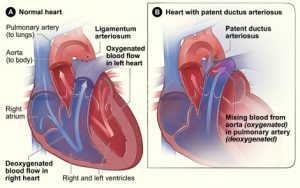
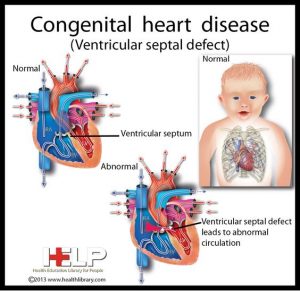
Are there risk factors that predispose certain mothers to having CHDs? What are they?
Maternal infections, maternal co-morbidities like diabetes, advanced maternal age, consumption of illicit drugs including herbal concoctions, etc. Generally, pregnant women should know what they are taking in. A lot the concoctions are derived from raw ingredients like tree barks, wood, herbs, etc. Some people would argue that most of the drugs manufactured are got from plants, but these are refined and tested for safety before they are pushed into the market. Sometimes we have almost 4 or 5 phases of trials before drugs are put on the shelf for sale; but some herbal mixtures are just concocted and put together and I daresay that even some people who mix these concoctions don’t know the contents themselves. It’s better to be safe than sorry; so even if people insist they must take it, they should avoid it in pregnancy. However, first trimester symptoms may be the first sign of pregnancy and this usually occurs at about 6 to 8 weeks when the heart and the baby’s body parts have already formed and whatever damage we are trying to avoid would have affected the baby.
Can some of these Congenital Heart Diseases remain till adulthood with or without treatment?
Yes, they can; but they usually would end up with complications. For the holes in the heart, when there is mixture of blood sometimes there can be excess flow of blood to the lungs, so the lungs are constantly congested and the pressures in the lungs can increase. That’s what we call pulmonary hypertension, that is hypertension in the lungs. The bad thing about complications is that they are like time bombs, so at any time the child could just have a cardiac arrest. There are some other conditions eg. the obstructions which tend to get severe as the child increases in age. So, a child who was previously not having symptoms in childhood may develop symptoms later in life. Some of these conditions may be compatible with life but when the child starts getting involved in activities; sports, even activities as basic as walking or running, they can now begin to manifest symptoms. Also, there are some that generally limit life, so in the first 24 to 48 hours, few weeks or months of life the babies die if they are major critical obstructions to either blood flow to the lungs or blood flow to the rest of the body.
What is the definitive treatment for Congenital Heart Diseases?
There are two types of treatments that can be given to children with holes in the heart. One is with drugs; but the drugs can only help the child’s clinical condition, they can never close the hole. The second is the surgical treatment where the hole is closed by surgical operation. The drugs are given just help to reduce the effects; for example, there are drugs that can be given to children who are very blue to reduce the blueness but that does not close the hole. For children who have recurrent fast breathing, chest infections, etc. there are drugs that can be given to reduce the amount of fluid in the lungs so that it can reduce the difficulty in breathing but it can never close the hole. The surgical treatment can either be open heart or closed heart surgery. The closed heart surgery is the one that can be done through a special means where umbrella-like devices are taken through the large veins of the leg and tracked up through pipes to reach the heart. It’s usually done under direct viewing like a television, just like non-invasive surgery. These umbrella-like devices are put into the heart and opened so that they form a plug where the hole is but this can only be done for small and uncomplicated holes. Then there is open heart surgery where the surgeon opens the rib cage and heart, directly views the hole and closes it up.
Sometimes Congenital Heart Diseases are very complex such that one surgery can’t solve the problem. So, it has to be done in a stage-like manner. It’s just like saying you want to build a storey building. You can’t just wake up one morning and start heaping blocks on top of each other, you have to go stage by stage so you do the foundation, do the first decking, second decking, etc. So, for some simple Congenital Heart Diseases, one surgical intervention can close the hole and that’s final, but for some children who have complex Congenital Heart Diseases, they have to undergo staged operations, usually it doesn’t exceed about 3 or 4 surgeries.
What are the signs/symptoms to look out for in a child with Congenital Heart Disease?
It depends on the type. For some of them they might manifest with fast, difficult breathing, some of them may have poor feeding in that they would have frequent stops while they are sucking especially at the breast, some of them would be failing to grow; their weight would not just increase. Some of them would sweat a lot on their foreheads, sometimes some of them may be blue at the mouth, toes, fingers. Sometimes some of them may have fainting episodes. For the older children, they could get tired easily, they may not be able to participate in sports without getting tired, they might feel their hearts beating, etc.
What early onset interventions can be adopted once Congenital Heart Diseases are diagnosed early?
Usually, drugs are commenced because even when surgery is available, it’s not on a walk-in basis. Investigations have to be done. So once a diagnosis is made, drugs can be started to improve the condition of the child while plans are being made for surgical intervention. Other things would include optimizing the nutrition of the child to ensure that the child is gaining weight, optimizing the blood level, attending to other problems that the child may have like an infection; to prepare a clear runway for heart surgery.
What are the diagnostic tests that can be done to make a diagnosis apart from the clinical signs and symptoms?
The major diagnostic procedures are:
1. A Chest X-ray – it would show us the size of the heart and show us if there’s a lot of fluid in the lungs
2. An Electrocardiogram(ECG) – It shows the rate and rhythm of the heartbeat
3. An Echocardiography Scan – it’s like an ultrasound scan where the structures of the heart are viewed
4. Cardiac Catheterization – where special tubes are passed to the heart to better qualify the structure of the heart when all these other tests have been done and the diagnosis is not yet complete
But the three basic ones are the Chest X-ray, ECG and the Echo Scan.
When should a mother whose child has a Congenital Heart Disease take the child to the hospital?
Once a neonate (a baby less than 28 days) or an infant (a baby less than 1 year) or child is not able to feed or is having recurrent episodes of cough or fast or difficult breathing, he/she should be taken immediately to the hospital for evaluation. Once a mother notices that the baby’s tongue or mouth or fingers and/or toes is blue, the child should be taken to the hospital immediately. Any of the other signs that I’ve mentioned, sweating excessively on the face, not being able to maintain breastfeeding for a prolonged period; all these are signs that something is wrong with the heart and the child should be evaluated further.
Thank you so very much Dr. Sokunbi for the taking time out of your busy schedule to educate us about Congenital Heart Diseases. And that’s all folks! I’m sure we have learnt a whole lot from this interview, I know I have. Let us know your thoughts by sharing your comments below and if you’d like to know more or have questions to ask, hit us up on our Q&A platform here.


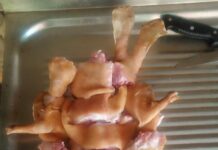





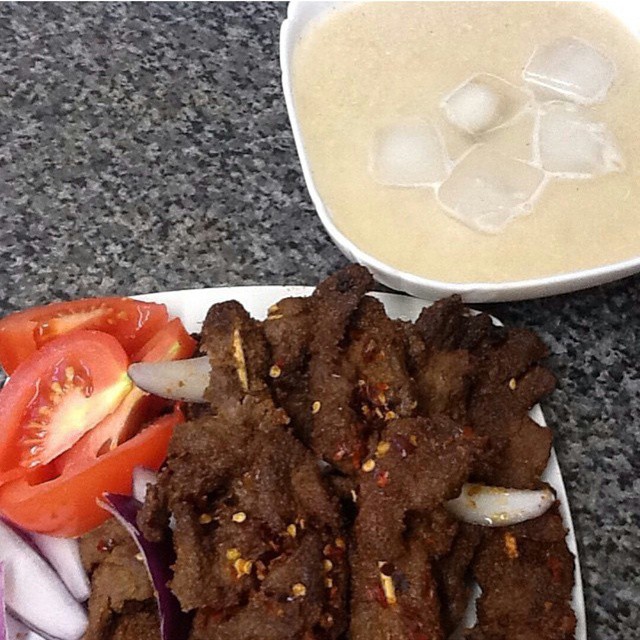
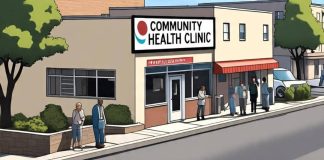
Whenn I initiaally commentedd I clickoed thee “Notify me when new comments are added” checkbox aand now each tume
a comment iis added I get three e-mails wijth thee same comment.
Is thre anyy way you caan remove people from that service?
Thaanks a lot!